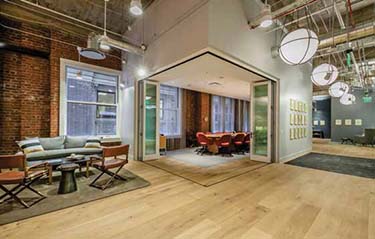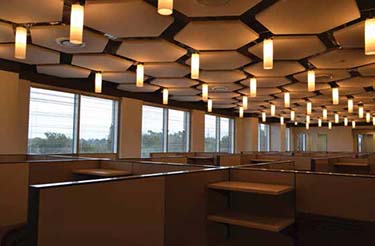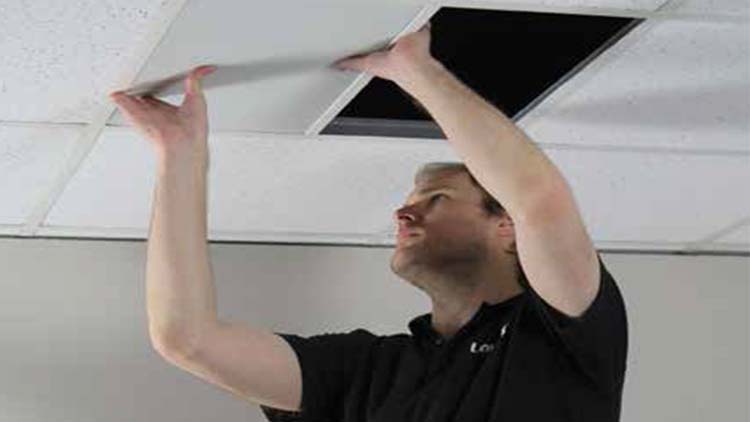There’s no disguising it—today’s office space is becoming a noisier place. With real estate costs only escalating in most desirable markets, employers have no choice but to crowd workers even closer together. And while colleagues aren’t physically on top of each other in these situations, their conversations are, and that’s a serious problem.
The quick-install Lowell LT speaker system features a driver that fires down for background music/paging and a masking driver that fires up for sound masking. “Interior designers are looking to place more employees in a given area than ever before,” said Steve Brooks, VP of masking products at audio solutions provider AtlasIED. “The open plan works well in this respect: office managers, architects, and interior designers want to create an open atmosphere of collaboration among employees, allowing everyone to see, converse, and exchange ideas with one another. Unfortunately, open plans reduce privacy, which leads to distractions and reduced employee productivity.”
“Open floor plans tend to be inexpensive, which is why they continue to be utilized,” added Kathy Lane, marketing communications manager for professional systems integration manufacturer Lowell. “Unfortunately, they can also generate low productivity, as well as low morale, since sound travels easily and conversations can distract workers not involved in the discussion at hand. Sound masking can improve the situation by limiting unnecessary distractions, thus improving both productivity and morale.”
Along with acoustical treatment, masking—speaker-driven low-volume sounds that make human conversation harder to understand and therefore less distracting—is increasingly required in open office spaces. And the time is now for integrators and manufacturers alike to get ahead of the problem, because the app world is getting in on the action: Websites like mynoise.net are offering the likes of “custom-shaped online noise machines” for the iPhone, encouraging sound-addled employees to personally take control of the situation.
But professional solutions are generally what are needed in larger office environments because the din is often attributable to more than just discussions. “It isn’t just the open floor plan concept that’s creating more noise,” said David Smith of sound masking solutions specialists Lencore, which recently introduced its new n.FORM rack-mounted operating platform. “The design decisions that the industry has recently embraced have incorporated many environment-positive choices. We see more metals, reclaimed wood, and the use of glass for daylighting purposes. We have also experienced a reduction in acoustical ceiling tile, carpet, and the use of partitions, opting for desking or benching solutions instead. All of this has removed the acoustical absorbent materials. That, coupled with more people in the same-sized space, creates noise.”

AV consultant TEECOM recommended the sound masking system QtPro from Cambridge Sound Management, which was installed by Electroboard for The Swig Company's collaborative spaces. In light of these complicated environments, manufacturers of masking solutions are seeing increased interest in their offerings. “These issues we speak of create opportunities for manufacturers of speech privacy equipment to offer solutions to help bring back some of the lost privacy that is experienced in open-plan office spaces,” said Brooks of AtlasIED, whose BlueBridge line of Open Architecture Networkable DSP products provide high levels of flexibility for integrators in need of custom designs. “Customers are looking for products that protect the open plan, private offices, and huddle rooms, products that can adjust masking levels depending on the activities and noise levels of a space, and products that are really unobtrusive in day-to-day work spaces.”
Mark Hughes is senior marketing manager for Cambridge Sound, whose offerings include the Qt Active Emitter, a single-source emitter capable of both sound masking and simultaneous clear reproduction of paging and music signals. “When designing an optimal acoustic environment, architects consider a variety of elements to address noise control and speech privacy: Elements added either absorb, block, or cover sound, and are collectively called the ABCs of acoustic design,” he said. “Sound masking is the ‘C’ part of the equation. With open offices, much of the materials that block sound—walls, partitions—are de-emphasized. Carpets and ceiling tiles that absorb sound are also out of vogue. So in many ways, architects, designers, and building owners only have one of the ‘ABCs’—cover—left at their disposal. We’re seeing tremendous demand for our sound-masking solutions as a result of the open-office trend.”
Although it seems counterintuitive, masking makes spaces seem quieter by introducing noise in much the same way as a public fountain or a babbling brook introduces serenity to its surroundings. “We can achieve this by gently introducing a noise that is slightly louder than background sound,” said Lencore’s Smith. “Masking creates a ‘beach’ or ‘coffee house’ effect by eliminating the distraction of indirect speech. It does not create a ‘cone of silence.’ Rather, masking allows you to know that there is activity going on around you, but you’re not distracted by it. You can still have a conversation or do heads-down work.”
In many office environments, the ideal calming solution is a mix of sound masking and acoustical treatment. “Sound masking cures the symptoms in many cases but does not get to the root cause of the issue—it does nothing to mitigate reflections and sound build-up in spaces,” said James Wright, business development for acoustic solutions provider Primacoustic. “Acoustic treatment can also help isolate and control unwanted sounds going to or from an area of the office. Offering both solutions in tandem is considered a best practice by the American Acoustics Association—virtually any space can benefit from acoustic treatment.”

The open environment of Florida tech company Highwinds’ new space allowed for collaboration, but made privacy difficult. Integrator Sound Stage suggested adding sound masking, installing a Cambridge QtPro sound masking system into the office’s unique ceiling. When it comes to sound masking systems, integrators today have more choices than ever, due to relatively fast evolution in the field since the open-office concept came to America in the late 1960s. “Today, technological advancements allow us to better analyze the uniqueness of the facility and deploy a solution that best meets those needs,” Smith said. “Technology has allowed us to put more speakers on a channel. There are varieties of speakers, from upward firing to downward firing to solid drive and decorative. It depends on the space. Technology puts more control in the hands of the user, giving them the flexibility to adjust the space as they see fit. And it has given us the ability to expand beyond just masking to incorporate other needs within a space, such as paging, audio, and mass notification.”
“As AV and IT have rapidly become one unit in recent years, masking equipment that can be put on a network for control and adjustment is one area of growth that I’ve seen,” said Brooks. “Masking equipment that can slowly and unobtrusively take control of the background sound levels while the space is occupied helps create greater acceptability of this technology. Masking speaker technology has changed as integrators ask for products that can be installed in shallow plenums, or speakers that can turn a door or window into a speaker, or speakers that blend well in ceilings that are open to the deck. Lastly, masking systems that are on their own LAN and powered individually—though expensive— allowing increased flexibility and accuracy, have become popular.”
Ongoing improvements in office acoustic solutions are advancing in step with an increased awareness: healthy sonics are smart business. “More people are beginning to understand that sound affects them in many ways,” Primacoustic’s Wright said. “It can be controlled and managed quite easily by absorbing unwanted sound energy and having a clear picture of how you want your space to sound. The end user and integrator need to understand what they want to achieve and what level of aesthetics versus acoustics they are willing to compromise. A little creativity can go a long way to bridging the gap between the two needs for the space to function correctly.”
David Weiss (dwords.com) writes extensively about AV, audio, and broadcast technology.
